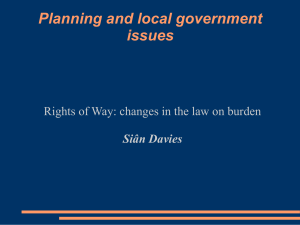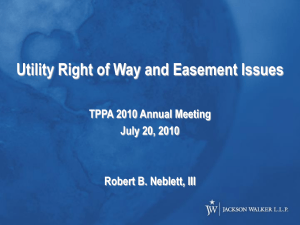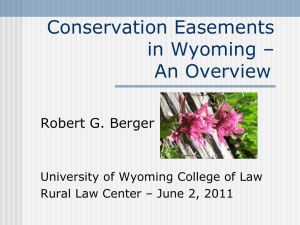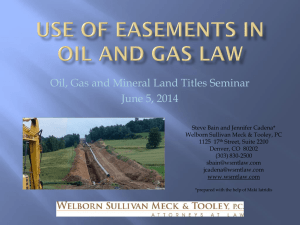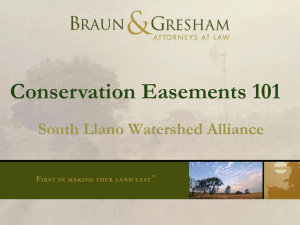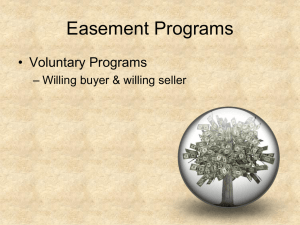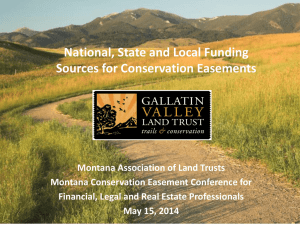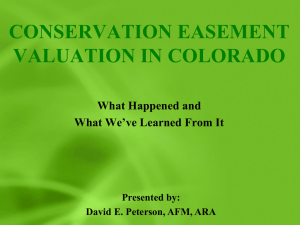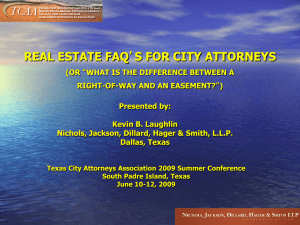Christian Dietrich - Montana Association of Land Trusts
advertisement
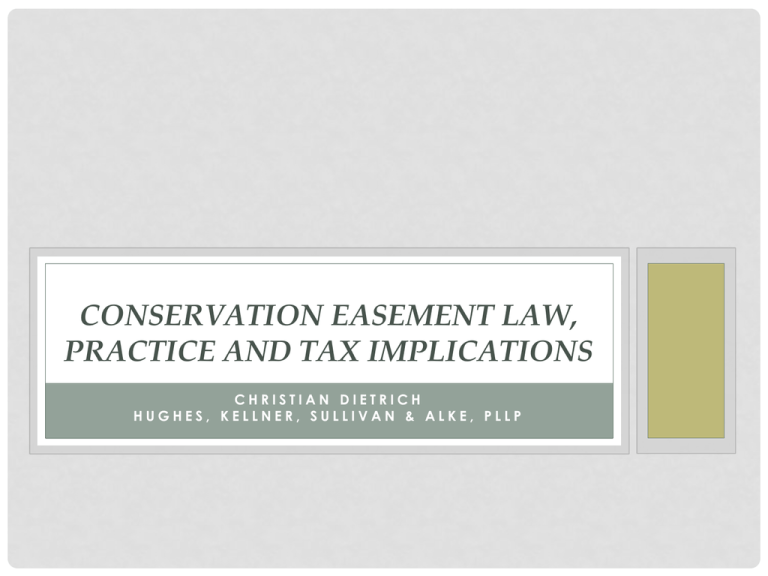
CONSERVATION EASEMENT LAW, PRACTICE AND TAX IMPLICATIONS CHRISTIAN DIETRICH HUGHES, KELLNER, SULLIVAN & ALKE, PLLP PART I—THE LAW 170(h) Qualified conservation contribution (1) In general For purposes of subsection (f)(3)(B)(iii), the term “qualified conservation contribution” means a contribution— (A) of a qualified real property interest, (B) to a qualified organization, (C) exclusively for conservation purposes. 170(h)(5)(A) and Treas. Reg. 170A-14(a) further require that the conservation purpose “must be protected in perpetuity.” QUALIFIED REAL PROPERTY INTEREST (2) Qualified real property interest For purposes of this subsection, the term “qualified real property interest” means any of the following interests in real property: (A) the entire interest of the donor other than a qualified mineral interest, (B) a remainder interest, and (C) a restriction (granted in perpetuity) on the use which may be made of the real property. QUALIFIED ORGANIZATION • Governmental entities • 501(c)(3) nonprofit organizations • Must have a “commitment to protect conservation purposes of the donation.” • Must have “the resources to enforce the restriction.” EXCLUSIVELY FOR CONSERVATION PURPOSES 170(h)(4) defines conservation purpose as: (i) the preservation of land areas for outdoor recreation by, or the education of, the general public, (ii) the protection of a relatively natural habitat of fish, wildlife, or plants, or similar ecosystem, (iii) the preservation of open space (including farmland and forest land) where such preservation is— (I) for the scenic enjoyment of the general public, or (II) pursuant to a clearly delineated Federal, State, or local governmental conservation policy, and will yield a significant public benefit, or (iv) the preservation of an historically important land area or a certified historic structure. “NATURAL HABITAT” IN ACTION: GLASS V. COMMISSIONER • Easement protected ~400 feet of shoreline (about 1 acre). Allowed for construction of walking paths, boathouse, shed, etc., but restricted most development. • IRS position was that no valid conservation purpose was present. • IRS lost at every level. Implicit argument that there is a size requirement for natural habitat was unsuccessful. • Takeaway: include recitation of natural habitats present on property unless need for flexibility outweighs advantages. • The IRS has also lost on natural habitat challenges in other cases, including Butler and Kiva Dunes. PRESERVATION OF OPEN SPACE (iii) the preservation of open space (including farmland and forest land) where such preservation is— (I) for the scenic enjoyment of the general public, or (II) pursuant to a clearly delineated Federal, State, or local governmental conservation policy, and will yield a significant public benefit. PERPETUITY 170(h)(5): (A) Conservation purpose must be protected A contribution shall not be treated as exclusively for conservation purposes unless the conservation purpose is protected in perpetuity. 1.170A-14: “To be eligible for a deduction under this section, the conservation purpose must be protected in perpetuity.” But: “[a] deduction shall not be disallowed . . . merely because the interest . . . may be defeated by the performance of some act or the happening of some event, if on the date of the gift it appears that the possibility that such act or event will occur is so remote as to be negligible.” MINERAL DEVELOPMENT • Surface mining must be prohibited at all times. Gravel extraction must be treated with extreme caution. • Certain “limited, localized” subsurface mineral extraction that is “not irremediably destructive of significant conservation interests” may be permissible. RESTRICTIONS ON TRANSFER Easement deed must: • Require any transfer of the easement to be only to another qualified organization. • Transfer must be conditioned on the “conservation purposes which the contribution was originally intended to advance” continuing to be carried out. RESTRICTIONS ON INCONSISTENT USES • Deduction disallowed if easement permits destruction of other significant conservation purposes. • Some IRS-approved uses of easementencumbered property: • • • • Selective timber harvest Limited mineral extraction Some commercial recreation (e.g., outfitting) Limited development BASELINE DOCUMENTATION 1.170A-14(5) explains: “when the donor reserves rights the exercise of which may impair the conservation interests associated with the property, for a deduction to be allowable under this section the donor must make available to the donee, prior to the time the donation is made, documentation sufficient to establish the condition of the property at the time of the gift.” NOTIFICATION AND INSPECTION Notification: landowner must notify donee in writing before exercising any reserved right that may adversely affect conservation interests. Inspection: easement deed must allow inspection to determine compliance with the terms of the easement, and must permit legal action to enforce restrictions. MORTGAGE SUBORDINATION Deduction is disallowed “unless the mortgagee subordinates its rights in the property to the right of the qualified organization to enforce the conservation purposes of the gift in perpetuity.” Necessary to protect against consequences of foreclosure. MORTGAGE SUBORDINATION IN ACTION: MITCHELL • Mortgage had not been subordinated at time of donation, but was two years later • Taxpayer argued possible foreclosure was “so remote as to be negligible” • Tax Court agreed with IRS that mortgage subordination at time of donation is a hard-and-fast rule. MORTGAGE SUBORDINATION, EXTINGUISHMENT AND RIGHT TO PROCEEDS • Lender must also subordinate right to proceeds. • Donee organization must be entitled “to a portion of the proceeds at least equal to that proportionate value of the perpetual conservation restriction.” • Requirement applies in foreclosure, extinguishment, condemnation settings MORTGAGE SUBORDINATION AND RIGHT TO PROCEEDS IN ACTION: KAUFMAN • Lender subordinated mortgage but retained priority in insurance or condemnation proceeds. • IRS prevailed in first two (of four) decisions, arguing that donee must be absolutely entitled to its portion of proceeds (the easement’s proportionate value). • IRS lost on appeal to First Circuit, which rejected the IRS’ position on absolute entitlement. • Taxpayers won the battle but lost the war—in March 2014 all deductions were disallowed because the easement had zero value. EXTINGUISHMENT IN ACTION: CARPENTER • Easement deed provided it could be terminated by mutual written consent if “circumstances arise in the future such that render the purpose of [the easement] impossible to accomplish.” • Taxpayer argued the “so remote as to be negligible” standard applied • IRS prevailed in Tax Court on argument that extinguishment requirement (must occur by judicial proceeding) is not subject to the “so remote as to be negligible test.” OTHER PERPETUITY CASES • Belk: property subject to easement must be clearly defined. • Graev: provision that easement would be reconveyed if tax deduction failed is unacceptable; “so remote as to be negligible” standard did not save the deduction. • Simmons: taxpayers successful with “so remote as to be negligible” standard with respect to provision that allowed donee to consent to changes or “abandon some or all of its rights hereunder.” PERPETUITY AND AMENDMENT OF CONSERVATION EASEMENTS • The Land Trust Alliance’s Model Conservation Easement allows the donor and donee organization to amend the easement jointly, provided the amendments are: (1) consistent with the purposes of the easement, (2) do not affect the status or qualification of the easement or the easement holder under applicable laws, including federal income tax laws, and (3) do not affect the perpetual duration of the easement. AMENDMENT AND CHARITABLE TRUST LAW DEBATE • Largely academic. • Reasonable support for both positions given the unique legal background of conservation easements. • Thank the Montana Legislature for letting you ignore the issue completely: The newly-enacted § 72-38-402 provides: “A conservation easement created or conveyed under Title 76, chapter 6, does not create a charitable trust unless the settlor expresses a clear intention in the conservation easement instrument to create or convey the conservation easement as a charitable trust.” DONATIVE INTENT • Question asked is: was there a quid pro quo for the easement donation? • Examples: • Donor gives easement to secure subdivision approval • “Reciprocal” easements. • Bargain sales do not run afoul of this rule. • Stewardship gifts should also be OK, but be careful (Scheidelman). SUBSTANTIATION REQUIREMENTS: APPRAISALS • Qualified appraisals required for all deductions greater than $5,000. • Must be attached to return if deduction exceeds $500,000, but good practice to include for all donations. • “Qualified appraisal” and “Qualified appraiser” now defined by statute. • Do not rely on substantial compliance with appraisal requirements! Some taxpayers have prevailed, but these decisions cannot be relied upon. OTHER SUBSTANTIATION REQUIREMENTS • Requirements include: • Contemporaneous written acknowledgment • Form 8283 and Supplemental Statement • Again, do not rely on substantial compliance, even though there is some support for the doctrine’s application. CONTEMPORANEOUS WRITTEN ACKNOWLEDGMENT The CWA must be issued by the time the return is due, and must include the following information: • The amount of cash donated and a description of any noncash property donated • A statement on whether the donee organization provided any goods or services in consideration for the donation • A description and estimate of the value of any goods or services provided in consideration for the donation. CWA IN ACTION: SCHRIMSHER, BRUZEWICZ • Schrimsher: façade easement deduction denied entirely for lack of CWA. IRS attacked the deduction on numerous grounds, but won on sole ground that no documents in the transaction stated that no consideration was provided for the gift. • Bruzewicz: IRS attacked on valuation and insufficient CWA (donee provided the donors a basic thank you letter that listed two cash contributions but not the easement contribution). • Other cases have turned out differently (see materials), but no consistency in these taxpayer-friendly rulings. Bottom line, again: do not rely on substantial compliance! 170(f)(8) means what it says. FORM 8283 AND SUPPLEMENTAL STATEMENT • Together, these forms require significant detail concerning the transaction. • Some success in court for substantial compliance with 8283 requirements, but follow instructions and don’t risk it. • The IRS has been perfectly willing to challenge deductions on the basis that 8283s aren’t properly filled out—even for the most technical of deficiencies. See cases. • Links in materials. Be an overachiever and do not leave this until the last minute—signatures of donee and individual appraiser are required. FORM 8283 IN ACTION: SCHEIDELMAN • Scheidelman submitted two Form 8283s, which together contained the information required. One contained the necessary information and signatures from the appraiser and donee organization; the other contained all of the rest of the information required. • Tax Court stated this did not comply with regulatory requirements (!) while denying deduction for lack of a qualified appraisal. • This portion of the tax court’s opinion was overturned, and the 8283 failure was excused on two grounds: "reasonable cause," see 26 U.S.C. § 170(f)(11)(A)(ii)(II); and the doctrine of substantial compliance.” LESSONS FROM CASE LAW • The IRS has learned from early losses and has shifted to making technical arguments it thinks it can win. • Easements attacked have thus far been “problem” easements for a number of reasons—façade easements, overvalued easements, clear lack of charitable intent. • An aggressive, litigious IRS is here to stay in the conservation easement arena, and Max is in China. • Take advantage of the wealth of resources at your disposal and develop familiarity with all of these requirements. Make it easy for the IRS to pick on someone else instead! PART II-THE MATH Current law on deductibility of easements • The “Fifty-percent limitation” generally applies to contributions of property held less than one year. • The “Thirty-percent limitation” generally applies to contributions of long-term capital gain property. • Excess deductions may be carried forward for five years after the year of the gift. DEDUCTION ALLOWED UP TO 50% OF CONTRIBUTION BASE IRC § 170(B)(1)(A) • • • • Adjusted gross income: $400,000 Value of land without easement: $2,000,000 Value of land with easement: $1,200,000 Amount of gift: $800,000 • A deduction is allowed up to 50% of $400,000 adjusted gross income ($200,000) in the year of the donation. • The remaining $600,000 can be carried forward for up to five years. • Assuming a steady income, the taxpayer will be able to deduct an additional $200,000 each year for the next three years before the full gift is deducted. DEDUCTION ALLOWED UP TO 50% OF CONTRIBUTION BASE IRC § 170(B)(1)(A) • • • • • • Adjusted gross income: $400,000 Value of land without easement: $6,000,000 Basis in land: $5,000,000 Value of land with easement: $3,000,000 Easement value: $3,000,000 Basis in easement: $2,500,000 • Amount of deduction: $2.5M (would be $3M, but is limited to basis) • A deduction is allowed up to 50% of $400,000 ($200,000) in the year of the donation • The balance of the donation, $2.3M, can be carried forward for up to five years • Assuming a steady income, the taxpayer will be able to deduct an additional $200,000 each year for the next 5 years • Only 40% of the full value of the gift, will be deductible DEDUCTION ALLOWED UP TO 30% OF CONTRIBUTION BASE FOR CONTRIBUTIONS OF LONG-TERM CAPITAL GAIN PROPERTY: IRC § 170(B)(1)(C) • • • • Adjusted gross income: $400,000 Value of land without easement: $2,000,000 Value of land with easement: $1,200,000 Amount of deduction: $800,000 • A deduction is allowed up to $120,000 in the year of the donation (30% of the taxpayer’s $400,000 income) • A further $120,000 will be deductible each of the next five years • 90% of the full gift will be deductible DEDUCTION ALLOWED UP TO 30% OF CONTRIBUTION BASE IRC § 170(B)(1)(C) • • • • Adjusted gross income: $400,000 Value of land without easement: $6,000,000 Value of land with easement: $3,000,000 Amount of deduction: $3,000,000 • A deduction is allowed up to 30% of $400,000, or $120,000, in the year of the donation • The balance of the donation, $2.88M, can be carried forward for up to five years • Assuming a steady income, the taxpayer will be able to deduct an additional $120,000 each year for the next 5 years • Only 24% of the gift will be deductible WHEN MIGHT 30% BE PREFERABLE? • • • Adjusted gross income: $1,000,000 Land value without easement: $5,000,000 Basis in land: $1,000,000 30% limitation • • • Land value with easement: $3,000,000 Easement value: $2,000,000 Basis in easement: $400,000 50% limitation Gift amount is $2M Gift amount is $2M Up to 30% of their $1M income($300K) can be deducted in the year of the gift Up to 50% of their $1M income ($500K) can be deducted in the year of the gift; but the deduction is capped at $400K, the taxpayers’ basis in the easement Additional ($300K)×(5) or $1.5M can be deducted in years 2-6 No additional deductions permitted. Able to deduct 90% of the gift’s value (1.8 M of $2 M) Able to deduct only 20% of the gift’s value ($400K of $2M) 30% AND 50% (SAME RESULT) • • • Adjusted gross income: $1,200,000 Land value without easement: $10,000,000 Basis in land: $6,000,000 30% limitation • • • Land value with easement: $6,000,000 Easement value: $4,000,000 Basis in easement: $2,400,000 50% limitation able to deduct 60% of gift able to deduct 60% of gift 30%×$1.2M=$400k/year for 6 years, or $2.4M 50% x1.2M =$600K/year for 4 years, or $2.4M More favorable if income is greater. More favorable if basis in property is greater. Income of $2M enables deduction of 90% of gift Basis of $9M enables deduction of 90% of gift 30% of $2M is $600k annually, over 6 years this totals $3.6M in deductions ($600K x 6) easement basis is $3.6M, which is fully deducted over 6 years ($600K x 6) ENHANCED INCENTIVES (FOR ALL) • Increased applicable percentage limitation for contributions of easements on property held longer than one year for all donors from 30% to 50%, without limitation to basis. • Excess contributions can be carried over for up to 15 years. • Special rules apply for farmers and ranchers and small ranching corporations. • • • Adjusted gross income: $400,000 Land value (held more than one year) without easement: $6,000,000 Land value with easement: $3,000,000 General Rules Enhanced Incentives Amount of deduction: $3,000,000 A deduction is allowed up to 30% of $400,000, or $120,000, in the year of the donation. Able to deduct up to 50% of $400K income in the year of contribution ($200K) The balance of the donation, $2.88M, can be carried forward for up to five years under § 170(d)(1). The balance of the donation ($2.8M) can now be carried forward up to15 years. Assuming a steady income, the taxpayer will be able to deduct an additional $120,000 each year for the next 5 years. Only $720K of $3M, or 24% of the gift, will be deductible. Able to deduct full $3M value of gift over next 15 years (with year to spare). ENHANCED DEDUCTIONS—FARMERS AND RANCHERS Who qualifies? Under IRC 170(b)(1)(E)(v): [T]he term “qualified farmer or rancher” means a taxpayer whose gross income from the trade or business of farming is greater than 50 percent of the taxpayer’s gross income for the taxable year. The contribution of an easement must be on property either “used in agriculture or livestock production” or is available to be used, and which is “subject to a restriction that such property remain available for such production.” (170(b)(1)(E)(iv)(II)). “FARMING” IRC 2032A(e)(5): (A) cultivating the soil or raising or harvesting any agricultural or horticultural commodity (including the raising, shearing, feeding, caring for, training, and management of animals) on a farm; (B) handling, drying, packing, grading, or storing on a farm any agricultural or horticultural commodity in its unmanufactured state, but only if the owner, tenant, or operator of the farm regularly produces more than one-half of the commodity so treated; and (C) (i) the planting, cultivating, caring for, or cutting of trees, or (ii) the preparation (other than milling) of trees for market. ENHANCED DEDUCTIONS—QUALIFIED FARMERS AND RANCHERS The deduction also applies to corporations meeting the 50% of income test, as long as: • Stock “is not readily tradable on an established securities market at any time during such year” (i.e., no giant agribusiness), and • The contribution of an easement is on property either used in agriculture or available to be used, and which is subject to a restriction that it remain available for such production. • • • • • • Adjusted gross income: $100,000 (60% from ranch operations) Land value without easement: $3,000,000 Land value with easement: $1,000,000 Amount of gift: $2,000,000 Basis in land: $300,000 Basis in easement: $200,000 30% Limitation able to deduct $50k annually for 6 years, or $300k (15% of gift) Enhanced Incentives for Farmers/Ranchers able to deduct $100k annually for 16 years, or $1.6M (80% of gift) 50% Limitation able to deduct $50k annually for 4 years (deduction capped at basis of $200k in easement) (10% of gift) Enhanced Limitation able to deduct $50k annually for 16 years, not subject to basis limitation, for total of $800k (40% of gift) FACTORS TO CONSIDER IN DETERMINING ACTUAL SAVINGS: OTHER CHARITABLE CONTRIBUTIONS • • • • • Adjusted gross income: $400,000 Land value without easement: $2,000,000 Land value with easement: $1,200,000 Amount of deduction: $800,000 Other charitable contributions (each year): $40,000. • Deduction up to $120k in year of donation (30% of $400K income) • Further $120k/year for next five years • $40k of other contributions is used against the cap before the easement contribution is considered • $80k worth of gift attributable to the easement donation will be deductible in each year, resulting in only $480k (60%) of the $800k gift being deductible under current law. ACTUAL SAVINGS: DIFFERENCE BETWEEN TAX SAVINGS AND TAX DEDUCTIONS The amount of deduction is obviously not the same as the amount of tax savings, as in the case of a tax credit. Consider Taxpayer A, an unmarried individual donating an easement on property held for less than one year (assume basis is same as value) • • • • Adjusted gross income: $400,000 Land value without easement: $2,000,000 Land value with easement: $1,200,000 Amount of gift: $800,000 Deduction allowed of $200,000, in the year of donation and in succeeding years (full gift used up in 4 total years)… ACTUAL SAVINGS: TAX SAVINGS VS. TAX DEDUCTIONS Federal tax rates for 2014 • 10% on taxable income from $0 to $9,075, plus • 15% on taxable income over $9,075 to $36,900, plus • 25% on taxable income over $36,900 to $89,350, plus • 28% on taxable income over $89,350 to $186,350, plus • 33% on taxable income over $186,350 to $405,100, plus • 35% on taxable income over $405,100 to $406,750, plus • 39.6% on taxable income over $406,750. Montana income tax rates for 2014: $620 tax on the first $16,700, plus 6.90% on remaining income. ACTUAL SAVINGS: TAX SAVINGS VS. TAX DEDUCTIONS WITHOUT the donation of the easement, Taxpayer A will pay tax on his full $400k of income in 2014: $115,858.25 in federal income tax and $27,067.70 in state income tax, for an overall effective tax burden of $142,925.95 (an effective rate of 35.7%). WITH donation of easement: Taxpayer A’s taxable income is reduced from $400k to $200k. Taxpayer A will owe $49,858.25 in federal income tax, $13,267.70 in state income tax, and $63,125.95 overall (an effective rate of 15.8%). The actual tax savings in year 1 is $79,800 for the 200K deduction. Future years’ tax savings may differ due to changes in tax rates, income, other charitable contributions, etc. ACTUAL SAVINGS: VALUE REPLACEMENT While many easement donations may never recover the “full value” of the easement, this omits consideration of what the saved money could be doing in the meantime. Example: Taxpayer E (H&W) donate an easement worth $10M. Their annual income is $600k. Under enhanced incentives, over the life of the easement they can deduct $300k annually over the next 16 years for a total deduction of $4.8M (less than half the value of the easement) and total tax savings of ~1.6M at a 33% effective tax rate. However, each year they will have an extra ~$100k of tax savings in their pockets. Assuming that they invest this savings at a 5% rate of return, 16 years later they will have over $2.8M as a result of their annual investment of the $100k in tax savings. At a 8% rate of return, this balloons to $3.8M. BARGAIN SALES Example: Taxpayer D agrees to accept $1.5M for an easement that reduces the value of the family ranch (long-term capital gain property) from $12M to $5M. The easement thus has a value of $7M. The uncompensated $5.5M ($7M-$1.5M) is treated as a gift. Taxpayer D’s annual income, not including the amount from the bargain sale, is $350,000. (Less than half of this amount is from the business of farming/ranching.) BARGAIN SALE—30% LIMITATION In year 1, Taxpayer D has income of $1,850,000 ($1.5M from the bargain sale and $350k annual income). He may deduct up to $555k (30% of contribution base). In years 2-6, Taxpayer D may deduct up to $105k. Total deductions: $1,080,000 (~20% of easement value). Total value recovered, assuming an effective 35% tax rate: $378k tax savings + $1.5M from sale = $1.878M, or 34% of easement value. (A pure donation would result in only ~4% of easement value recovered: 35% of a deduction of $105k annually for 6 years). BARGAIN SALE— ENHANCED INCENTIVES Year 1 deduction = 50% of 1.85M, or $925k. Years 2-16 deduction = $175k. Total deductions: $3.55M (~65% of easement value). Total value: $1.24M tax savings + $1.5M from sale = $2.74M, or ~50% of easement value. (Pure donation: ~18% of easement value recovered). If the bargain sale payment and all tax savings are invested throughout the life of the deduction at an 8% rate of return, in year 16 the total value of these investments will be ~$8.6M, or over 150% of the value of the gift! C CORPORATIONS C corporations are subject to a 10% annual limitation on their taxable income, unless they are qualified farming and ranching corporations. Taxable income is smaller than adjusted gross income because it is reduced by all deductions. Corporation C has an adjusted gross income of $2M and a taxable income of $1.5M, and donates a conservation easement reducing the value of land it owns from $10M to $5M. It may deduct up to $150k (10% × $1.5M) in the year of the donation and in the following 5 years, for a total deduction of $900k (18% of gift). S CORPORATIONS • As with partnerships and LLC’s, charitable contributions are “passed through” to shareholders in proportion to their ownership interests. • Under existing law, deductions for contributions made by the corporation will only pass through to shareholders to the extent of their basis in their stock in the corporation. • Under enhanced incentives, deductions are no longer limited to basis in stock and S corporation shareholders may deduct their proportionate share of the corporation’s contribution (like partnership or LLC interest holders). Shareholders’ basis in stock is reduced by the shareholder’s proportionate share of corporation’s basis in the easement. • Each individual must independently qualify for qualified farmer/rancher status. SIMPLIFIED EXAMPLE: S CORP—”FIX” IN PLACE Corporation S is owned in equal shares by Taxpayers W, X, Y and Z. It donates an easement reducing the value of land it owns from $4M to $2M. The corporation’s basis in the land is $2M (basis in the easement is thus $1M). W has a basis in stock of $100k. Each of the other shareholders have a basis in their stock of $400k. Each of X, Y and Z are entitled to $500k of deduction (1/4th of the total $2M contribution); bases in stock are reduced from $400k to $150k. W reduces his basis in the stock to 0, and may not (yet) take the full deduction because his basis in stock is exceeded by his share of the basis in the donated easement. He is entitled to deduct his full amount of the “gain” portion of the easement, or $250k (1/4th of the total $1M of the donation attributable to gain), but may only take $100k (his basis) of the remaining $250k attributable to the basis portion of the easement (1/4th of $1M of the basis portion of the donation.) SIMPLIFIED EXAMPLE: S CORP—”FIX” NOT IN PLACE (CURRENT LAW) Facts Application Corporation S is owned in equal shares by Taxpayers W, X, Y and Z. It donates an easement reducing the value of land it owns from $4M to $2M. The corporation’s basis in the land is $2M (basis in the easement is thus $1M). W has a basis in stock of $100k. Each of the other shareholders have a basis in their stock of $400k. Instead of the full $500k, X, Y and Z are only able to deduct up to their basis in stock: $400k. W is limited to a $100k deduction. Each owner’s basis in their stock is reduced to 0 after taking these deductions. If their bases rise in the next five years, the deduction may be taken. ESTATE TAX BENEFITS: IRC § 2055 Makes clear* that for purposes of estate tax calculations, property encumbered by an easement is counted at its restricted value. • Regardless of whether the decedent was the original grantor. • Also regardless of whether the original donation qualified for a federal income tax deduction at the time it was made. ESTATE TAX BENEFITS: EXAMPLE OF LAND WITHOUT CONSERVATION EASEMENT H&W own a beautiful parcel of land between them, worth $15M, using bypass trusts. They have other assets of $2.5M. Total assets: $17.5M. Estate Tax Consequences: If H dies first, his taxable estate will include $7.5M (his share of the land); the other assets pass tax-free to W under the marital deduction. 40% estate tax will be due on the $2.16M not excluded by the $5.34M exclusion: $864k. W’s taxable estate then includes $7.5M (her share of the land) and the remaining other assets less the estate tax already paid ($2.5M$864k = $1.636M), for a total of $9,136,000; she will owe 40% tax on this amount less the $5.34M exclusion, for a total tax bill of $1,518,400 (40% × ($9.136M-$5.34M)). Total estate tax paid by H&W: $2,382,400. ESTATE TAX BENEFITS: EXAMPLE OF LAND WITH CONSERVATION EASEMENT Assume the same facts as the previous example, except that during their lives, H&W have the wonderful idea to donate a conservation easement that reduces the value of their land from $15M to $7.5M. Estate Tax Consequences—Easement donation H dies first and has a taxable estate of $3.75M (half of the restricted value of the land); the other assets pass to W free of tax under the marital deduction. All is sheltered by his $5.34M exclusion. W dies second and has a taxable estate of $3.75M plus the other assets of $2.5M, for a total of $6.25M; she will owe tax of 40% on (6.25M-5.34M), for a tax bill of $364k. To avoid tax entirely, H could avoid the marital deduction by passing ~$1M of other assets directly to children at his death, thereby obtaining a taxable estate of $4.75M (still less than the $5.34M exclusion); W’s estate would then fall under the $5.34M cap as well at $5.25M). ESTATE TAX BENEFITS: IRC § 2031(C) An additional exclusion is allowed by 2031(c) of 40% of the restricted value of the land, up to $500,000. A number of requirements make this provision difficult to take advantage of: • Ambiguous restriction on commercial recreational activity • Land must be owned by decedent or family member for previous 3 years • Easement must have been donated by decedent or family member • Historic preservation easements do not qualify • Unclear relationship with a § 2032A election 2031(C): EXAMPLE Taxpayer Q donates a conservation easement that reduces the value of her land from $2M to $1.5M (the land is in a remote area and is not subject to any development pressures). An additional $200k worth of buildings are not counted for purposes of determining value under the subsection. She meets all 2031(c) requirements. Q would be entitled to a further exclusion of 40% of $1.5M, or $500k, whichever is lower (and here that is $500k as 40% of $1.5M is $600k); however, because the value of the easement is less than 30% of the unrestricted value of the land (it is only 25%), the 40% figure is reduced by 2 percentage points for each of the 5 percentage points by which 25% is less than 30%, leading to an applicable exclusion percentage of 30%. Q is therefore entitled to a $450k exclusion: 30% of $1.5M. QUALIFIED PERSONAL RESIDENCE TRUSTS Can a conservation easement-encumbered property be placed into a QPRT? • Only property “reasonably appropriate for residential purposes” may be placed into a QPRT. (Treasury regulations state a 200-acre farm cannot be placed into a QPRT as it exceeds this definition of qualifying property). • If residential area of property is excluded entirely from the easement, QPRTs may be an available tool. • Size of what is an appropriate “residential area” will be determined by facts and circumstances. CONTACT INFORMATION Christian Dietrich Hughes, Kellner, Sullivan & Alke, PLLP 40 West Lawrence, Suite A P.O. Box 1166 Helena, MT 59624-1166 (406) 442-3690 Or email me at: cdietrich@hksalaw.com
